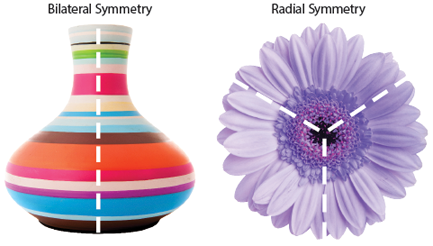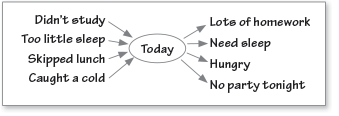Critical-Thinking Activities
The activities listed below will help you work on your critical-thinking skills and become a more thoughtful learner.
Pattern Finding
You’ve already sought out spiral patterns in each of your classes. The activity below will help you explore two other patterns across the curriculum.
Your Turn Look at the two illustrations below. One shows bilateral symmetry—a line down the middle divides the form into similar halves. The other shows radial symmetry—any line through the midpoint reveals similar halves. Find an example of each kind of symmetry in your current science, math, English, and social studies classes. Why does each type occur?

Causes and Effects
Human beings live in time. What came before impacts what is happening now, which in turn will affect what happens in the future. Considering these causes and effects connects you to your past and to your future.

Your Turn What kind of day are you having? What factors caused this day? Create a cause-effect chart about your day. What causes could you change to have a better day tomorrow? See the example at the right.
Identifying and Isolating Variables
The kind of cause-effect analysis you did on the previous page about your day can also help you think about your day’s constants and variables.
Your Turn Think about your day. List its constants and its variables. Choose one variable to isolate; then indicate how you would turn all the other variables into constants. Use the following example:

Creating Algorithms
On page 19, you created a flowchart algorithm involving a robot and a peanut butter and jelly sandwich. Here’s another chance to practice computational thinking.
Your Turn Imagine you have a robot that understands the commands below. Create a flowchart algorithm that directs the robot to high-five you and then give you a fist bump.
- Clamp: Close left or right hand.
- Unclamp: Open left or right hand.
- Lift: Raise left or right hand.
- Lower: Drop left or right hand.
- Pull: Draw item nearer.
- Push: Move item farther.
- Twist: Turn left or right hand clockwise or counterclockwise.
Rubrics for Life
By setting goals and listing objectives for achieving those goals, you can effect positive changes in your life.
Your Turn Write out your number one goal in life as a single sentence. Answer the 5 W’s and H about the goal. Plug your goal and objectives into a basic rubric sheet (thoughtfullearning.com/h28). Evaluate your progress so far and consider what you must still do to reach your goal.
